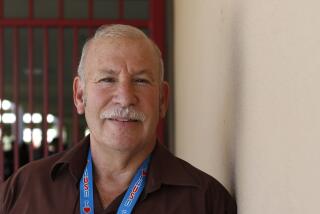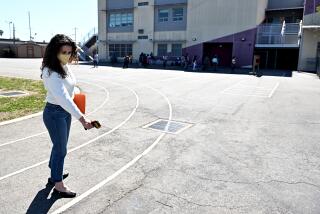Hertzbergâs Gimmick
Los Angeles mayoral candidate Bob Hertzberg correctly figures that his best shot at rising above the crowd of competitors for the cityâs top job is to appeal to the San Fernando Valley, which he represented for six years in the state Assembly. And he was politically crafty in handing voters the only specific idea in the campaignâs first mayoral debate. But the idea, ultimately, was insulting -- a half-baked rendition of a recurring proposal to break up the Los Angeles Unified School District.
Hertzberg acknowledges that the mayor of Los Angeles has no authority over the cityâs schools, but he imagines that resurrecting the call for breakup will boost his support among voters with a soft spot for secession -- voters who may not realize that Hertzberg opposed a proposal to allow Valley schools to split from the district three years ago. Then, he was Assembly speaker and in a position to help make it happen. Now heâs relying on political gimmickry -- like a yellow-school-bus tour of campuses in his opponentsâ neighborhoods -- to position himself as the education candidate.
Hertzbergâs âplan,â as outlined on the campaign website to which he refers inquiries, is a series of platitudes about the importance of âneighborhood districtsâ and a promise to appoint a task force to deal with details down the line. Plans that shift power to neighborhood schools have been tried in the district and withered without making a dent in the shameful dropout rate or raising student scores. In fact, what recent improvements Los Angeles schools have made have come through a centralized approach to curriculum and school construction.
That doesnât mean that breaking up the sprawling system -- the second largest in the nation -- might not be a good idea. Smaller districts could draw greater community support, allow more innovation and support programs tailored to neighborhood needs. Hertzberg is banking on discontent among middle-class San Fernando Valley voters who feel shortchanged in a giant district overwhelmed by the needs of poor and minority kids. Particularly stinging was the news this month that thousands of classroom seats promised to Valley schools when voters approved a school construction bond last spring will be built at inner-city schools instead. The change was forced by a legal settlement intended to relieve overcrowded year-round schools.
Hertzbergâs plan simply offers too little to be taken seriously. It fails to recognize, much less resolve, the thorny issues that have doomed breakup proposals in the past -- how to untangle district finances, apportion school construction, promote desegregation and prevent one large, bloated bureaucracy from morphing into dozens of smaller but no more effective ones. Thereâs no hint of how a mayor could order the all-too-independent school district to do anything.
Itâs a grab for visibility, not a path to education reform.
More to Read
Get the L.A. Times Politics newsletter
Deeply reported insights into legislation, politics and policy from Sacramento, Washington and beyond. In your inbox three times per week.
You may occasionally receive promotional content from the Los Angeles Times.










